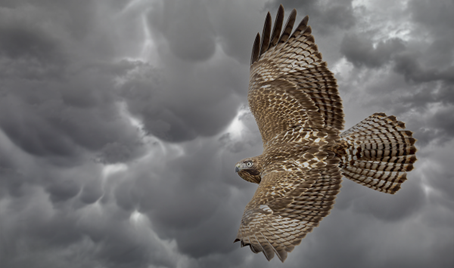We see things as we are (& so do elephants): How wildlife reminds us to open up.

‘Bird of Prey’ ©Curtis Anderson – used with permission
Lately, when I’ve felt frustrated with myself, someone else, or the world, I’ve gotten into a new habit of letting my mind wander to the lives of animals. Try it out. For a minute, consider the sensory experience of being a Peregrine Falcon on a 200-mph downward dive towards the earth, or living the Mayfly’s harried, ephemeral journey from birth to death in a matter of minutes. Imagine the daily stressors of an 80-year-old Orca Matriach, demonstrating to Great White Sharks that her pod is dominant. These creatures all have such vastly different perspectives on being alive, and it helps remind me there are infinite ways of seeing the world.

After rabbit holes of “researching” about these animals’ sensory experiences, I’ve closed my eyes and tried to picture what it would feel like to cut through the air as a bat in darkness, relying on the sounds of clicks to build a mental map or to hatch in the sand as a baby sea turtle and be drawn into the vast ocean moments later by a some intuitive force as seagulls hungrily circle above.
Ed Yong demonstrates these concepts beautifully in his book, An Immense World, where he places an elephant, a mouse and a bat all into the same theoretical, school gymnasium together, yet he reminds us that despite sharing a physical space, they are operating on profoundly different sensory planes, each continuously building their own reality.
We can consider, what is our constructed reality? When I frantically scurry around trying to control “my world,” can I pause and notice some of my habitual thinking? Some of the classic OC thoughts bouncing around include:
-This isn’t enough. I must be better.
-I have to find a way to fit it all in.
-This problem did not have to happen if I would have just worked harder.
I can be challenged by thinking about a 200-foot, thousand-year-old Redwood Tree who has found a way to exist in its environment for millennia without ever consciously lifting a limb, and ask myself: Can I loosen up just a little? Could I use less effort? When a monarch butterfly sets off on a two-thousand mile journey with its paper thin wings, I wonder, how can I be more adventurous?

Perhaps these thought experiments feel inspiring or maybe there’s also an edge in there worth exploring? For me, I think of self-enquiry questions like:
- What if despite all my extra efforts to control, I can never really eliminate risk?
- Is life really “supposed” to become amenable to MY preferences and needs 😱?
- What might others be seeing in this situation?
In seeing our diversity across species, I can also see commonality. We share something with the female tree frog (whose noise-cancelling lungs will filter out the sound of the croaks of any subpar male suitors). As each moment passes, we too are filtering through volumes of sensory input and constructing our own dashboard display of reality. As RO DBT teaches us, we can’t ever really know THE reality, because we’re seeing things as we are, not as they are.
So, perhaps if we can learn more about our own blindspots and perceptual biases’, it might invite more awe, kindness, and a little more connection in these wild, wild times.